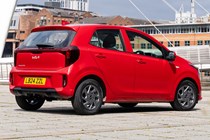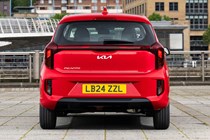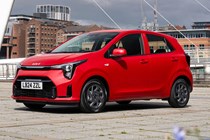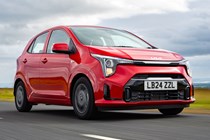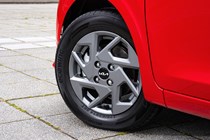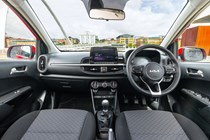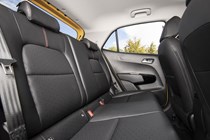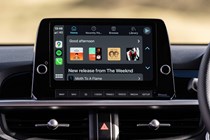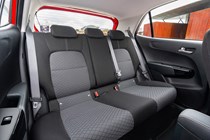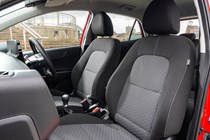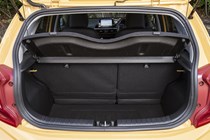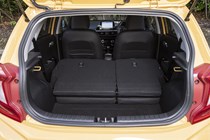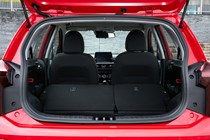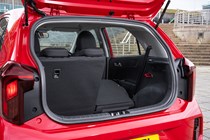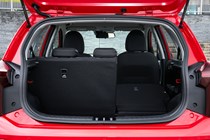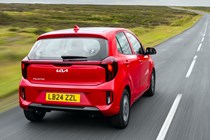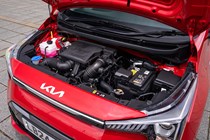Kia Picanto long-term test
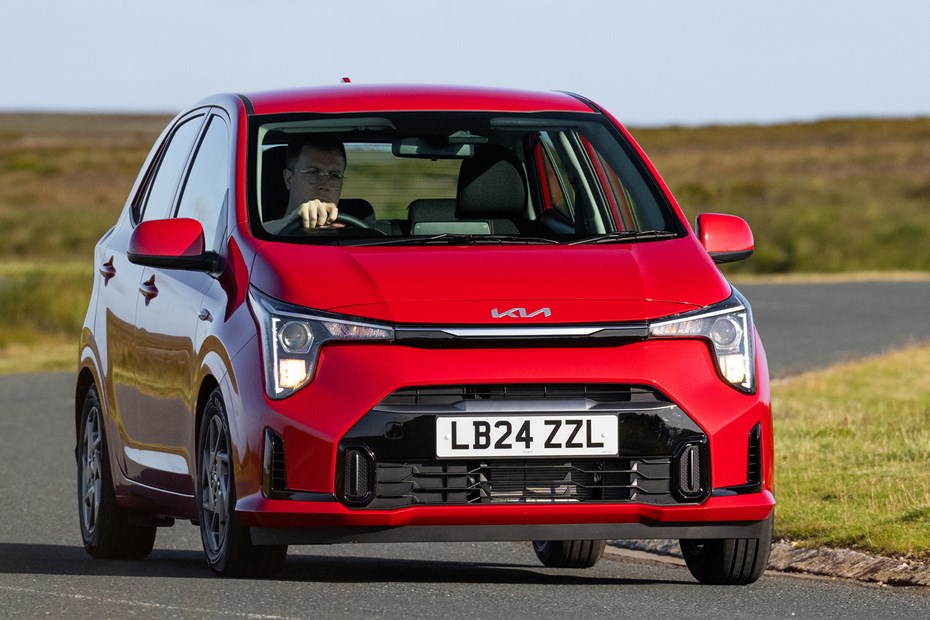

Update 1: Welcome
The third incarnation of the Picanto has garnered positive reviews since its launch in 2017, with the range topping, performance orientated GT-Line model also winning its fair share of plaudits. The aggressive styling, sharp handling and exhaustive kit list of the small city car impressed at launch, but many questioned whether the power plant lived up to the car’s sporting ambitions. While the 1.25 litre four-cylinder engine is a great free revving unit, it couldn’t really be considered a true performance motor.
New engine
Kia has now added the T-GDi three-cylinder engine to the GT-Line range. It’s only 1.0-litre in capacity, but comes equipped with direct injection and a turbocharger, which boosts it’s performance to 99hp up from the 1.25 litre’s 83hp. It’s an engine which is shared with the Picanto’s bigger siblings, the Rio and Ceed.
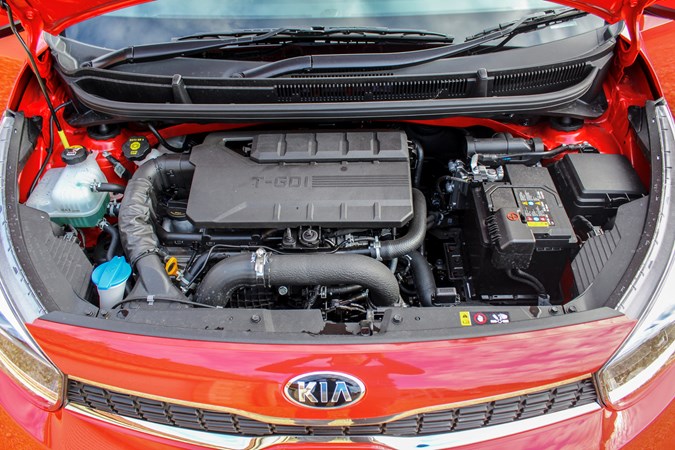
The result is the most powerful engine that’s ever been available in a Picanto and it’s this engine in GT-Line spec we have on test for the next six months. Will this new addition make the GT-Line a true mini hot-hatch it so wants to be? Over the coming months we will no doubt find out.
It had to be red
Our Picanto comes in the premium Chilli Red finish. While the fine-flecked metallic paint provides a dazzling deep finish it’s worth noting the four other colours available all come with sporty red body trim around the front bumper and door bases. Those red details are swapped for chrome on our model. That makes our car look more sophisticated but loses some of the visual sportiness that comes with the other colour variants.
This GT-Line arrives in the ‘S’ variant and is packed with a bewildering list of options and goodies. There are some real big car features, including:
- Autonomous emergency braking
- 7.0-inch touchscreen sat-nav with RDS, DAB, Apple CarPlay and Android Auto
- Climate control
- Wireless mobile phone charger
- Cruise control and speed limiter
- Rear parking sensors and reversing camera system
- Heated front seats and steering wheel
- Electric sunroof
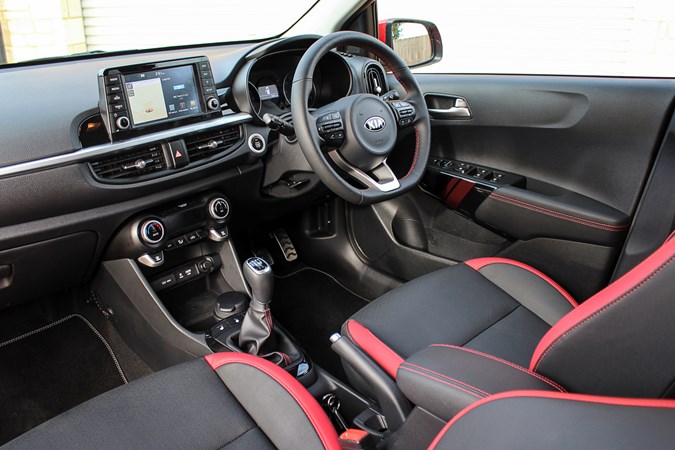
With the only additional option the £515 premium paint finish our Picanto comes in at £15,235 on the road. That’s not cheap for a car of this size but then there’s an incredible amount of kit bundled within that price.
Update 2: Performance and handling – what’s it like to drive?
The Picanto’s power delivery is present right from the off with no hint of turbo lag. Turning out of my drive onto a clear country lane I kept accelerating and that sharp, instant tug kept on pulling right through the rev range up to the red line of 6,500rpm. The T-GDi engine has a rorty sound that makes me think it could be very addictive indeed. Kia has used some clever variable valve timing and crankshaft design to achieve this light-switch fast power delivery. That delivery is remarkably linear too, building smoothly right up to the red line.
The ride also has a sporty setup. It’s firm but not harsh and still adequately comfortable for gentler journeys. The only downside is it can be noisy inside the cabin, not from the delightfully resonating engine but from road noise. Small city cars often compromise on sound deadening to save weight and cost. Combined with the Picanto’s wider, lower profile tyres it’s noticeable how much din is coming from the road. Travelling along a recently graveled road the Kia made a real racket and sounded like an upside down hailstorm.
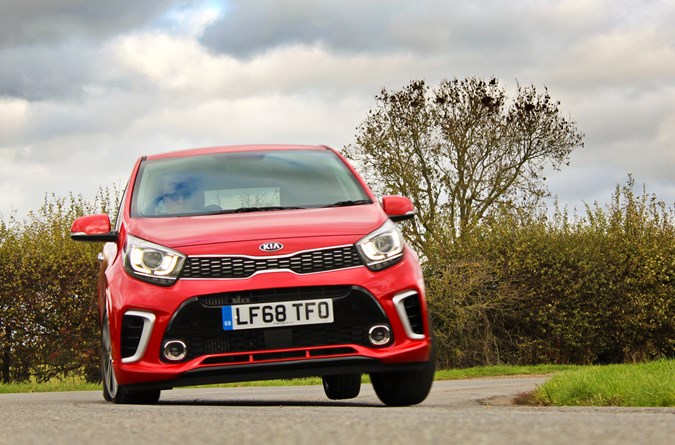
The handling completes the performance car feel. It’s composed and offers an incredible amount of grip. So much so that occasionally the front end will dig in on a corner and turn too much. Fortunately this deviation is well telegraphed and can easily be dialed out without any drama.
Fast, but not that fast
The T-GDi engine does make the car feel a lot faster but we’re not quite up to hot hatch territory yet. The power to weight ratio of the Picanto clocks in at 98hp per tonne but if you compare that to a benchmark hot hatch like a VW Golf GTi it’s a different story. Looking at the bare figures the Kia probably couldn’t be considered a true hot hatch but the important factor is it feels faster than it is.
There’s the noise and drama under acceleration, there’s the sporty ride and even the diminutive size of the car all contributing to a feeling of rapid speed and excitement. This lack of outright performance also makes the car more fun. You can explore the outer limits of the car’s abilities without worrying if you’re going to end up in a hedge or adding points to your license.
Other superminis and hatchbacks with some sort of performance bias I’ve driven have all had sophisticated handling while offering a good level of refinement. The Picanto feels raw in comparison. Not that I believe the rawness is intentional, to make the driving experience more sporty and engaging, but more a result of sticking a powerful engine and wider tyres on a pretty basic small city car. Intentional or not the feel of the GT-Line S T-GDi works for me, I like the extra road noise, the engine sound under acceleration too fills the cabin.
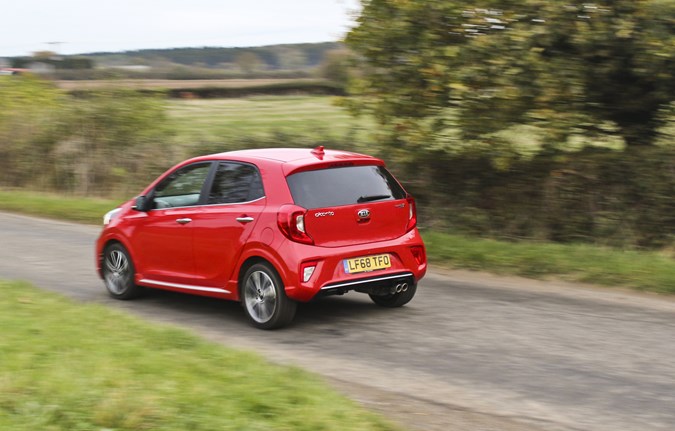
On narrow lanes with at least half of the corners unsighted you have to slow sometimes to a crawl to negotiate safely – the Picanto is really in its element with this type of terrain. With quick bursts from an almost standing starts to 30 or 40mph and then braking sharply for the next tight corner and accelerating once again. The Picanto feels rapid at these lower speed roads. Only on longer straights does the lack of outright pace show that this is a warm rather than hot hatch.
Another area magnified by driving other larger performance hatches is the amount of bodyroll the Picanto suffers from when cornering. This is not a car that’s spent months on a proving ground getting its suspension tweaked and honed to accommodate the bigger and wider wheels. If you want something with a more sophisticated ride and handling and you’d better look at a supermini sized car and upwards. Still, even though the car lacks sophistication there’s a no-nonsense charm to this city car that’s a little addictive.
It’s so good in fact that I’ve been trying to think of a time when I last had this much fun in a car this small. I realised it must have been a good 20 years ago and after a quick look in an old back issue of Car magazine I discovered it was in fact exactly 20 years ago.
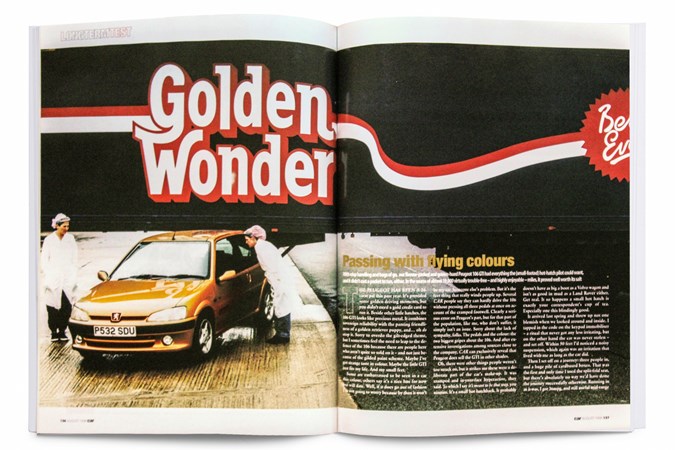
Back in 1997/98 my then colleague at Car magazine, Paul Horrell, ran a Peugeot 106 GTi as a long-term test car for over a year. At the time his house was quicker to get to by walking than driving on the congested streets of London so he didn’t have much cause to use it during the week. I gladly snaffled the keys every night and ended up racking up as many miles in that car as he did.
It made my commute home to South East London from our city centre office an absolute hoot. I remember our repro house couriers had plotted a route for me made up of their tried and tested rat runs through East London and the Blackwall Tunnel. It got me home in half the time and actually made it a pleasant, relatively traffic-free journey. Very quickly, thanks to the 106, I fell in love with the concept of small hot hatches, they just seemed to make so much sense driving in the city.
New decade, same problem
Back in the day when fuel efficiency was less of a priority, manufacturers threw capacity at an engine to give you the thrills. I remember the 106’s naturally-aspirated four-cylinder 1.6-litre engine was great in the mid-range revs and went a little frenetic, in a good way, at even higher revs.
It seems the conventional wisdom these days that to reach equivalent performance while reducing emissions you need a turbo. What it does mean is the Kia’s engine is much more responsive at lower revs than the icon from 20 years ago and makes for even more pleasurable driving in the city, bursting away from the lights at a rapid rate.
With these two approaches to performance engine design you’d think there would be wildly different fuel economy readings but after 20 years of development the figures are still very close. The 106 – after 14 months and 18,000 miles – clocked in at 33.2mpg. And with the latest 1,000 miles of motoring, the Kia posts a figure of, yes you guessed it, 33.2mpg. The 106 actually generates 20 more horsepower than the Kia and slices a good second off the 0-60 time.
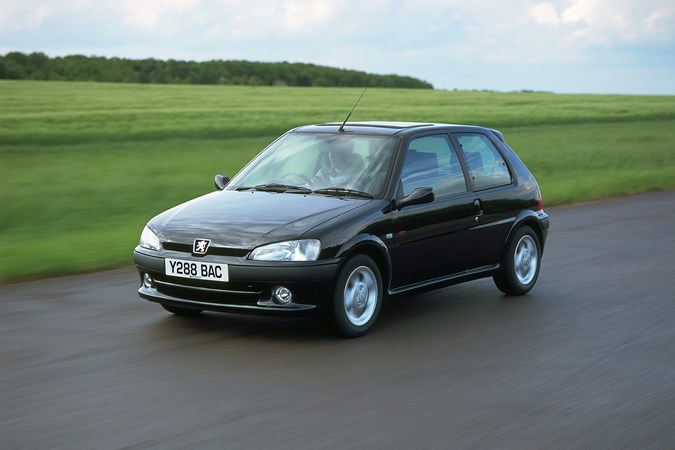
I remember the Peugeot generally felt a lot faster although the Picanto’s rorty engine note makes up for some of that lost sensation. It just goes to show that despite the Kia having an undoubtedly more sophisticated engine than its 90s counterpart there is still no magic bullet to making a performance engine frugal too.
So will the Picanto with its T-GDi engine join the 106 GTi in hot hatch folklore and be wistfully talked about in 20 years time? Probably not to the same extent, although I know I’d worry less about the Picanto’s legacy and take the Kia’s elegant and gizmo packed interior every time. That’s enough progress for me.
Update 3: Comfort and interior

The Picanto is positioned as a small city car but that hasn’t stopped me from using the car for my usual demanding workload. Straight after delivery the Kia was pressed into service with some long distance commuting – it suffers from a lot of road noise that is amplified at motorway speeds. You can drown it out using the six speaker sound system but volume has to be pumped up to sometimes uncomfortable levels.
A lack of adjustable lumber support on the front seats meant my taller than average frame was left in a hunched position giving me a heavy dose of backache. I bought my own lumber support pillow to help alleviate the problem but the sports seat design meant the pillow didn’t fit well and was soon abandoned.
There were some positives on the long motorway jaunts, the cruise control was intuitive to operate and the controls are well positioned on the steering wheel, it’s certainly novel to be using such a system on a car as small as this. Overall though, I couldn’t wait to get back onto A and B roads, if anything, to give my ears a rest. The occasional long motorway trip is bearable but anything more regular and I’d recommend a larger and more comfortable middle of the range car.
Quality interior
The Kia’s interior is a very considered and fine detailed affair. There are tasteful red flashes on the quality leather-look seats. Intricate red stitching around the black door grabs. Even the additional cheaper plastic door panels are well coordinated in black and red graphics.
This is by no means a luxury interior, there are still cheaper plastics left over from the base models but overall it’s a well designed, tasteful place to be, putting bigger, more expensive cars to shame. In GT-Line S spec the standard options list is impressive – I wonder if some of those toys are there for the brochure list rather than being genuinely helpful.

The electronically folding mirrors can’t be set to when the car is turned on and off so I rarely remember to use them, though.
The big car spec
This small city car has a big car level of spec and my new winter-time ritual when getting in the car is to deploy the heated seats and steering wheel immediately. I’ve always thought heated steering wheels are a little gimmicky but combined with the heated seats, there is no quicker way to get warm on a cold winter morning. They really are very rapid.
I’m a really big fan of the finish on leather look seats too. They’re very convincing and tastefully upholstered with small red panels and red stitching. They’re even more practical as the smudges left by dark jeans on the red flashes wipe off with a damp cloth. I’ve had to buy expensive leather cleaning products to do the same job with real leather seats.
One feature not tested so far is the wireless charging point. I’m a bit behind the times with my tech but luckily my daughter’s splashed out on a new phone.
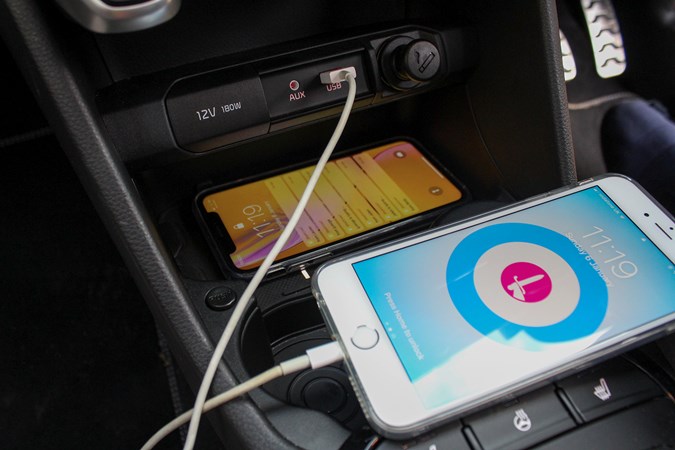
The charger panel is conveniently placed just in front of the gear stick so you can almost throw it in place when you get in. Once in place the charging is completely automatic. It now means we can charge two phones at once, one wireless and one wired through the USB slot. Although you still need to plug it in to use Apple CarPlay. The USB option also charges a lot faster too which makes the wireless charger seem a little redundant in most circumstances.
What’s it like for passengers?
My weekly motoring patterns usually involve a lot of ferrying people around but again I haven’t let the size of the Picanto excuse it from my taxi service duties. One week I was picking up my parents and visiting auntie from a night out, the next it was a shopping trip for the whole family.
All four full seats were occupied and all passengers, even the adults praised the amount of rear space available, head and legroom seemed more than adequate. There were less positive comments about the ride quality in the rear. One complained that they ‘felt every bump in the road’ and another who had gone from sitting in the front to the rear perceived a noticeable stiffening to the ride when in the back. The ride has never been that forgiving, It’s firm without being harsh and that’s how it’s mostly stayed so far despite the Kia finding some horrendous freshly mined pot holes.
I even had someone claiming it had damaged their back but then we were travelling along a road a local TV programme had described ‘the worst in Britain’. My back seemed to cope with this extreme test well but then the ride in the front might be a lot kinder. Because of where the rear seats are positioned passengers are sitting right over the rear axle.
Update 4: Practicality
The other day the Kia had to shift something a little bigger. It was nine foot artificial Christmas tree (yes, I’m the one who buys Christmas decorations in the January sales).
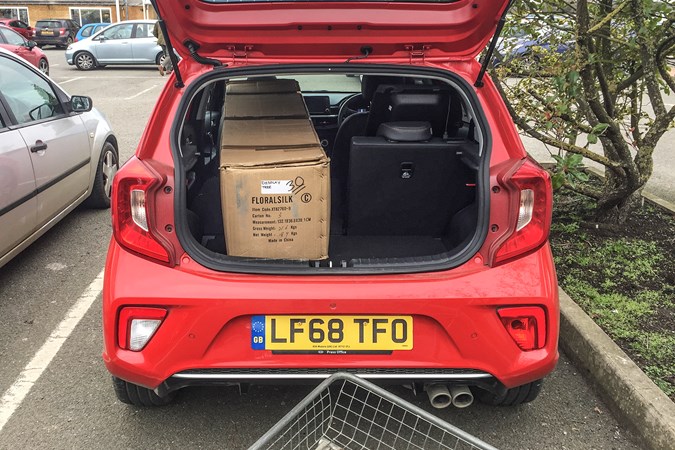
To flatten the rear seats was just one small pull on a lever on top of the seat. The seats were tensioned to fall flat so there was no awkward wrestling seats into place. Similarly the front passenger seat was spring loaded like a three-door car front seat and it plopped into place immediately. Those two small tugs is the least amount of effort I’ve had to employ to flatten car seats. Full marks to Kia there.
Despite having a bigger car within the family I still like to take the Kia on the weekly trip to the supermarket. Mainly because the boot is much bigger than you’d imagine and it’s so easy to park. I can almost get the families shopping in the boot with perhaps the odd bag sitting on the rear seat.
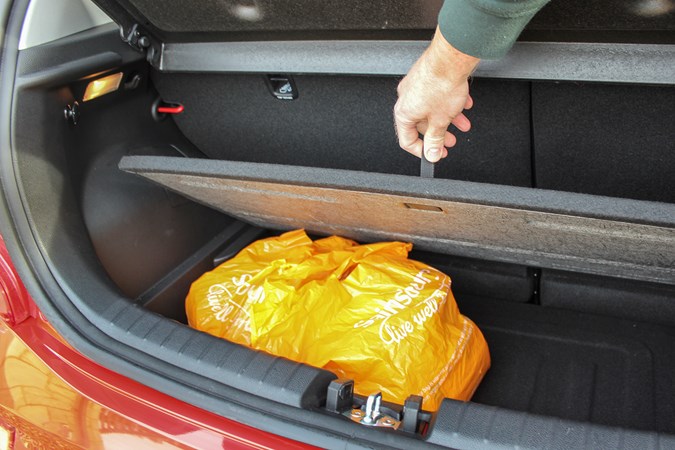
That’s not surprising because the Picanto boasts best in class boot space. It also comes with a handy shelf that sits half way up the boot and stops the bottom row of shopping getting crushed.
Now the weather has changed, though, it seems impossible to keep this little Kia clean, especially the rear of the car. Because of the Picanto’s flat-sided rear styling it seems to suck up all the crud from the road.

That covers one of this car’s better features, the rear parking camera. The system usually has excellent picture quality, even in low light, but after only a few days rain all you see when reverse is engaged is a splattering of dirt.
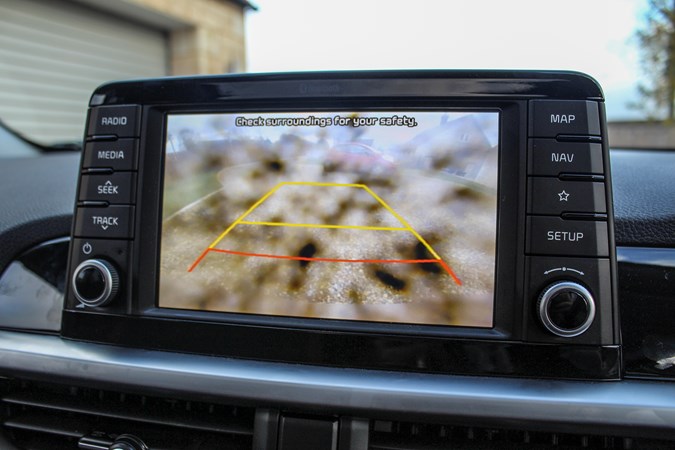
I’ve now trained myself to give the smartphone-like lens a little wipe whenever I open the boot.
Is it good in the city?
A trip to Leeds to take my daughter to a University interview meant a couple of hours on the motorway to get there. With Apple Maps very confused by the location of the University’s car park, we had to stop and try Kia’s built in sat-nav system.
As you’d expect with a native navigation system it’s no way as intuitive as the Silicon Valley software equivalents. The clunky menus and manual entry of any data means it’s always a last resort compared to simply barking orders using voice recognition with the Apple set-up.
Beating nearly all traffic away from the lights is the Picanto’s neatest party trick. It meant I then had precious added milliseconds to decipher the sat-nav and make the right choice with the native traffic closing in behind me, hands on horns ready.
When I did make a wrong choice and ended up in a dead end street I could call on the Picanto’s black cab-like turning circle to swing the car around with little commotion.
The Picanto’s size is a real benefit, it’s a particularly narrow car and can squeeze into all sorts of gaps making progress seem swift. Even our parking space at the now full multi-story was only available because no one else could fit in it.
Mission completed
On the return leg the Picanto’s extra horsepower meant it felt at home on the city’s rapid ring roads and despite it now being rush hour we were clear of town within 20 minutes. Again the Picanto surprised a fellow car by being first away from the lights.
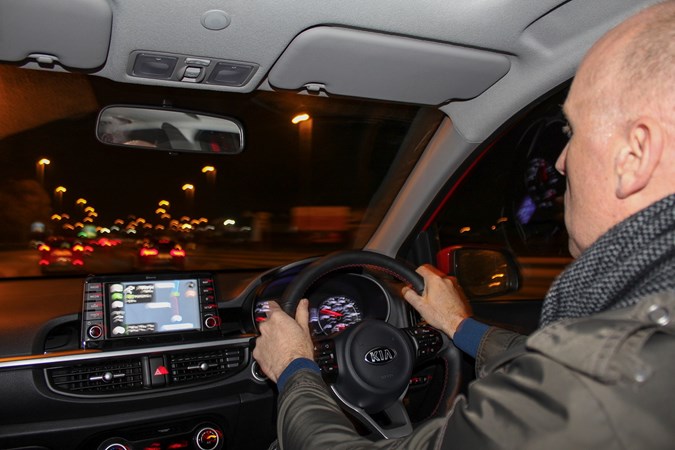
At the next set the Audi RS3 made no mistake but it did look like it was trying a bit too hard.
The Picanto can be a little notchy going through first and second gears. It’s hard to get a completely smooth transition, but you do forget there’s a turbo boosting that performance and it’s undetectable, no turbo whine, no sudden boost of power mid corner. Overall you can accept a slight lack of smoothness considering the trick the engine is performing.
Back on the motorway I reflected on the Picanto’s intense introduction to city driving. It had all the attributes to make it a complete success. It’s very swift, highly manouverable and small enough to make use of gaps other cars can’t. If I lived in a city full time, I’d want one of these.
Update 5: Picanto vs Rivals
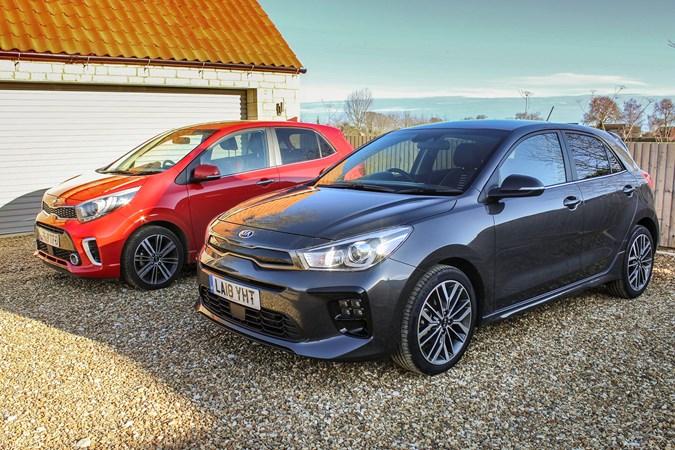
I thought I’d take a look at some of the T-GDi rivals. There aren’t too many warm or hot city cars on the market. Most city cars are kept to sensible, insurance friendly, vanilla spec. Jump up to the supermini sector and there’s a plethora of performance orientated hot hatches out there but in the world of the city car there’s only three or four. Here’s a few of them.
Abarth 595
The performance version of the Fiat 500 starts at £15,980, £1,260 more that the Picanto T-GDi GT-Line S. That gets you 16-inch alloy wheels and a fairly well-trimmed cabin, with sports seats, metal-finished pedals, a leather gearknob,
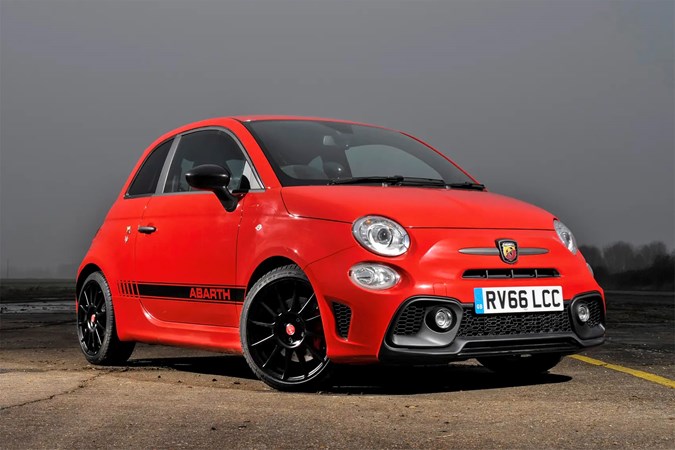
There are aso TFT instruments and a basic infotainment system with a five-inch touchscreen. Performance wise the engine is considerably more powerful at 143bhp compared to the Picanto’s 99hp. With a similar kerb weight to the Kia that translates to an impressive 0-62 time of 7.8sec, a full two seconds quicker than our car.
While it boasts impressive performance from it’s four cylinder engine it’s worth bearing in mind that despite a facelift in 2016 the fundamentals of the Fiat 500 are still the same from it’s launch in 2007. It’s starting to feel it’s age and feels less sophisticated than more modern cars. There’s also an unusually high driving position that doesn’t particularly feel that sporty.
VW Up GTI
The headline figures of a £14,315 starting price, 113hp engine and a 0-62 time of 8.8sec certainly makes the Up GTI look an enticing alternative to the Picanto T-GDi GT-Line S. It’s more powerful, faster and cheaper than the Kia.
It has the same engine layout as the Picanto, a 999cc turbocharged three-cylinder engine but squeezes an extra 14 horsepower from its unit. The interior is well-appointed, stylish and has a quality feel. It uses styling cues from VWs rich history of GTI production, a theme that translates to the exterior styling too. It really looks the part.
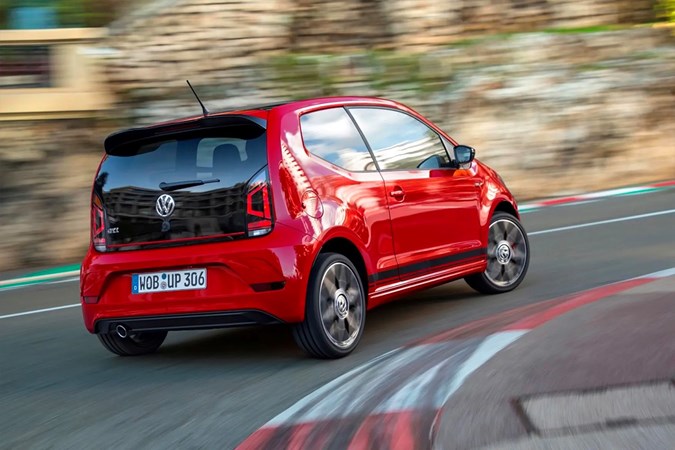
What is lacking on the Up is the tech inside. There is no satnav or infotainment screen in the Up, not even an optional one. Instead, there’s a built-in holder on top of the dash so you can mount your smart phone and use its functions to direct and guide you.
Some would argue that your own smartphone is more intuitive and powerful than most car infotainment systems. Generally though the Up is not as lavishly equipped as the Picanto. A cruise and park pack and rear view camera would set you back an additional £540 but beyond a Beats sounds system and Climate control there’s not even the option to match the Picanto’s standard equipment. In that regard the Kia’s £400 price difference seems very good value. Where the Up shines is with its driving dynamics. As you’d expect from a company with so much hot hatch experience the ride and handling is superb.
Kia Rio
The 1.0 T-GDi GT-Line Eco is the warm hatch equivalent of the Picanto T-GDi GT-Line S we’ve been running. The super mini comes fitted with the same engine as our Picanto, although in a slightly different state of tune. Peak power delivers 118hp at 6,000 revs where our Picanto musters 99hp at 4,500 revs.
While there is some very close characteristics, like the same rorty noise, they do behave very differently. The engine in the Picanto delivers it’s burst of power early on where in the Rio the engine feels strongest at the back end of the rev range.
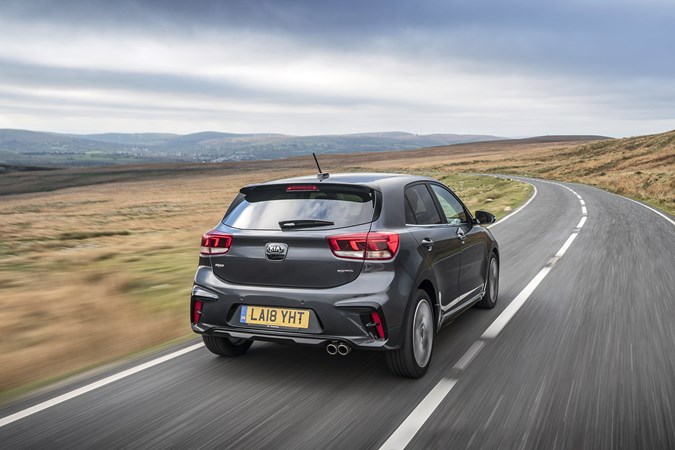
This might explain the slightly back to front fuel figures I’ve been getting from both cars. Despite being a heavier car by 145kg and with a higher state of tune the Rio has consistently posted a figure of 40.5mpg, which is over 5mpg better that the engine in the Picanto. The addition of a sixth gear must be helping the Rio achieve those figures but it seems the Picanto is paying the price for it’s off the line shove.
Should you upgrade?
I’ve talked before about how the Picanto is pricey for a car of it’s size, softened by the fact it’s got a big car kit list. The more competitively priced Rio in this spec is a much bigger more comfortable proposition offering near identical performance figures on paper, all for an extra £1745. In reality the cars are poles apart.
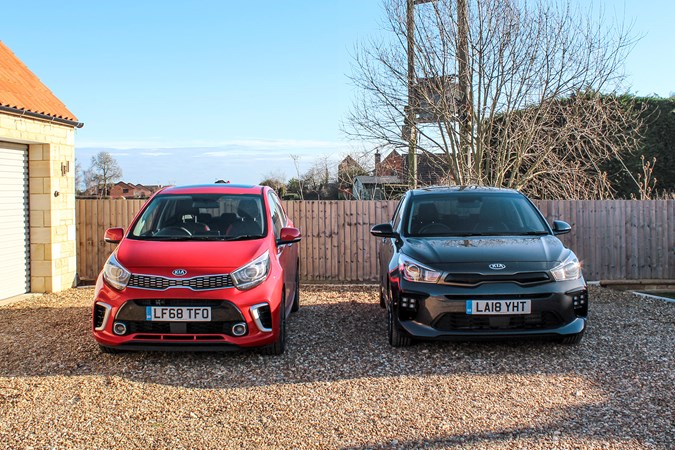
While the Rio is spacious and has a very comfortable ride when it comes to the corners it feels too soft and the steering feel is a little vague. I’ve complained about the Picanto’s road noise being too loud before but with the Rio it’s to the other extreme. It can be hard to hear the roar of the engine with the extra sound deadening fitted to the Rio.
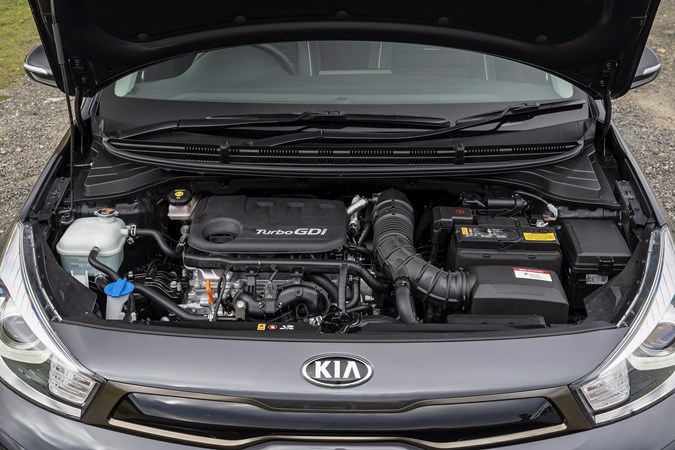
Overall the Picanto delivers a raw performance car experience and is therefore a more exciting car to drive.
The Rio features just a hint of a performance car feel while offering a cultured and comfortable ride that is beyond a car of this size. It’s worth noting that the extra cost and size of the Rio means it enters the very competitive world of the supermini sector, where there is a huge choice of sporty and great handling cars at very keen prices.
Update 6: Verdict
Our six-month test of the Picanto GT-line S is at an end and it’s time to give our verdict. Has the frisky new 99hp engine given the aggressively styled GT-line edition the performance boost it needed? Has the extra power transformed this humble city car into a pocket-rocket?

Engine
The turbo helps to bump up the power figures from 83hp on the standard GT-line model to 99hp in this GT-Line S. For me it’s the real highlight of the car. It hasn’t the performance a true hot hatch would command but what it lacks in power it makes up with a boatload of character. The sound under acceleration has the sweetest, rorty note and became increasingly addictive as my stint with the Picanto progressed.
There is no hint of lag and combined with tuning that favours the lower revs it really packs a punch away from a standing start. Only towards to the top of the rev range does that punch become more of a half-hearted swipe. That makes it the perfect engine to dart around town and city but fun out on rural roads too. Find a twisty stretch and the dart and braking between corners becomes pleasantly exhilarating.
Handling
The GT-line gets wide, low profile 16 inch wheels which offers a decent amount of grip in corners but there is a noticeable amount of body roll mid corner. That has the effect of making the offside front end dig in as you exit which then requires a slight adjustment in steering. So not the most fluid of handling cars but by no means bad, just not as sophisticated as some slightly larger superminis.
Ride and comfort
Those lower profile 16 inch wheels look great but the result is the ride is quite firm. Combined with city car spec sound deadening, which isn’t much, made longer journeys a little tiresome. Early on the Picanto had a spell of motorway commuting and I would often arrive a little exhausted with a ringing in my ears. The smaller city car sized seats would also cause some discomfort. They lacked any adjustment for lumber support and contributed, along with my tall frame, to a driving position that felt as if I was hunched over the wheel.
The Picanto is a small and narrow car, there’s not much on the market that is smaller in dimensions but inside it doesn’t feel cramped or claustrophobic. My children gave it the big thumbs up for legroom, that’s despite me having to push my seat back to the last stop to accommodate my height. They did complain about the ride though, more than the passengers in the front seats. The rear seats are positioned directly above the rear axle and transmit every bump in the road.
Interior and equipment
The GT-Line S is a very well equipped car. Sat-nav, rear facing parking camera, Apple CarPlay/Android Auto, heated front seats, heated steering wheel and a wireless phone charger are all standard items. There’s safety equipment too in the guise of Emergency Stop Signaling (ESS) and Autonomous Emergency Braking (AEB) which I can confirm works very well having been distracted a few times in slow moving traffic.
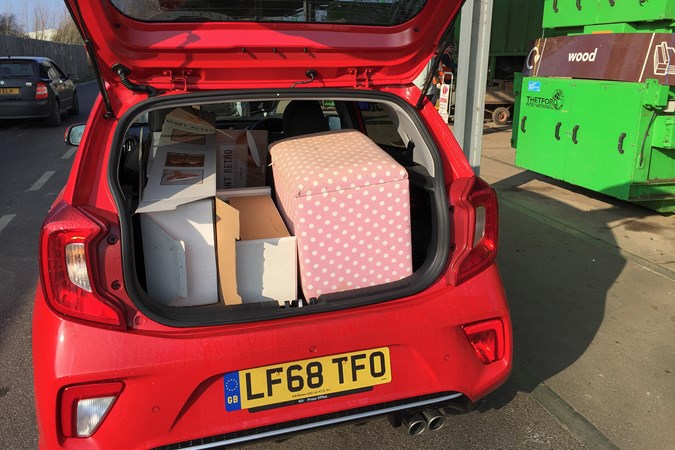
The fit and finish of the interior is in general excellent with only a few cheaper plastics left over from base models. The black and red faux leather is very convincing while being a whole lot more practical than the real thing. I was able to wipe away grime with a damp cloth that would normally require some fancy leather cleaning product. There simply isn’t another city-sized car on the market that comes close to the interior quality or it’s list of equipment.
Fuel economy
You can expect a car with a performance credentials not to deliver the best fuel figures but I must admit I was still disappointed with the fuel economy of the GT-Line S. There were times when I was disciplined enough to achieve a reasonably frugal driving style but was still unable to record anything higher than 35mpg. I’d say in this day and age that makes this city car a little thirsty. In a previous post I talked about running a Peugeot 106 GTi test car nearly twenty years ago and how that car had identical fuel economy. Perhaps that lack of turbo lag and off the line grunt does come at a price.
Should you buy a Kia Picanto?
The GT-Line S is not a cheap car. Our Picanto came with an extra paint option (£515) which pushed the price up to £15,235 on the road. That’s sailing into sporty supermini territory and is a very competitive sector where the cars are slightly larger and are generally more sophisticated.
I would recommended checking out some of that supermini competition before you make a decision. That’s unless small city car dimensions are a must. When Kia came to take the Picanto away and I watched it drive down the road for the last time I couldn’t help feeling a little sadness. The Picanto is not an out and out performance car but it is a characterful and a very likable car. I really enjoyed driving it in most situations and I think it gets under your skin more than you think it will.



